The Parsons Trading Company
In a contract dated 13 July 1916 (and modified on 4 August) the Parsons Trading Company of New York agreed with M. C. Rolland, the duly authorized representative of the Mexican Government acting in particular for the Government of Yucatán, to print this new issue. According to the contract the notes were to be:
| Series | from | to | total number |
total value |
|
| $1 | A | 000001 | 5000000 | 5,000,000 | $ 5,000,000 |
| $2 | B | 000001 | 2500000 | 2,500,000 | 5,000,000 |
| $5 | C | 000001 | 3000000 | 3,000,000 | 15,000,000 |
| $10 | D | 000001 | 1500000 | 1,500,000 | 15,000,000 |
| $20 | F | 000001 | 500000 | 500,000 | 10,000,000 |
| $100 | G | 000001 | 100000 | 100,000 | 10,000,000 |
| 12,600,000 | $60,000,000 |
and so a variation (and combination) of the amounts authorized by the two decrees, núm. 536 and núm. 550. The first four denominations were to carry the legend ‘La Tesorería General del Estado’, stated to be obligatory in accordance with decree núm. 550 of 23 May and signed by the governor, Alvarado, and acting tesorero general, Victor M. Cintra. The two highest denominations were to be entitled ‘La Comisión Reguladora del Mercado de Henequén’, to be acknowledged as bono de caja issued according to decree nûm. 536 of 9 May (as modified by decree núm. 555[text needed] of 29 May) and signed by Alvarado, as Presidente del Consejo General, and Julio Rendón, as Gerente General (General Manager).
The designs were to be prepared by Parsons from rough drafts furnished by the state. As well as the obligatory portraits of Benito Juárez and Francisco I. Madero, the vignettes were of Moctezuma(?) and various Mayan archaeological sites.
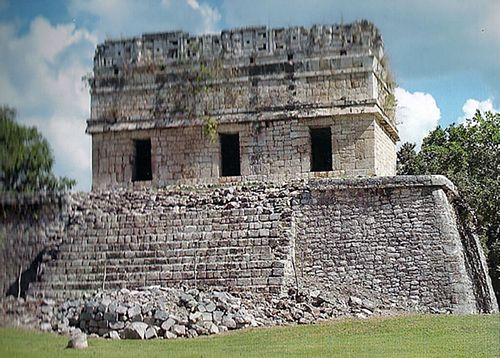
Chinchanchob
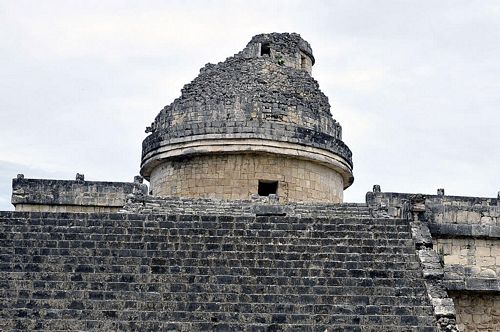
El Caracol
Chichanchob at Chichén Itzá is the largest and best preserved of the four buildings surrounding the main plaza. Chichanchob means "small holes" in Maya and the name is given after the small holes in its raised ridge. The building consists of a vestibule accessed by three entrances and three rooms located at the rear, and can be dated to 850 AD.
Decree núm. 550 and the original contract had specified that the notes would be ‘al portador a la vista’ but the latter phrase was removed in the modification to the contract.

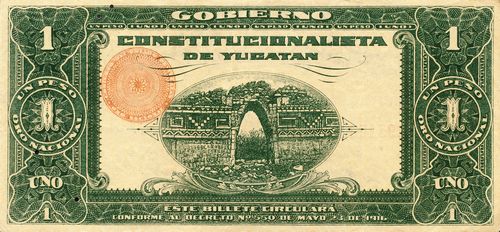 M4132a $1 Tesorería General
M4132a $1 Tesorería General
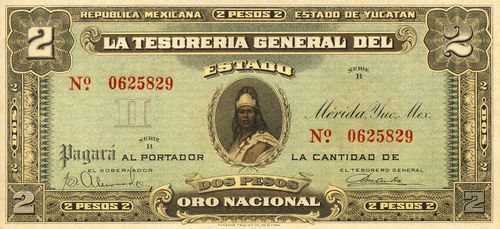
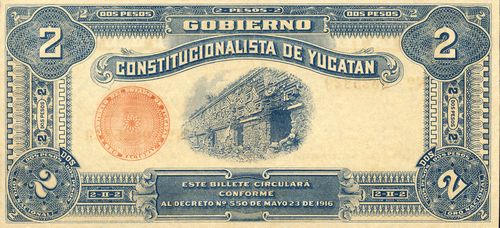 M4133a $2 Tesorería General
M4133a $2 Tesorería General
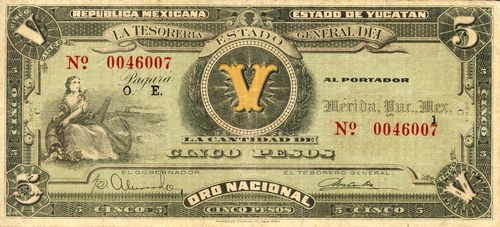
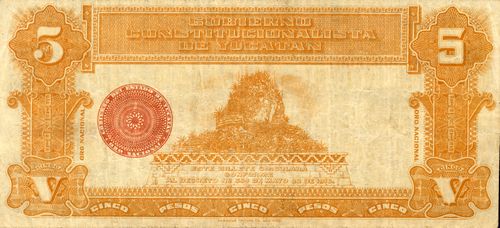 M4135a $5 Tesorería General
M4135a $5 Tesorería General
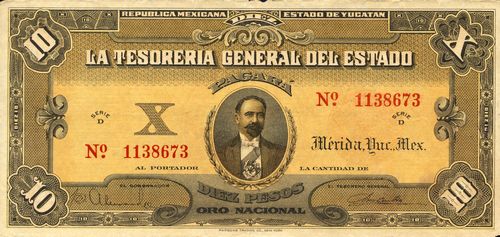
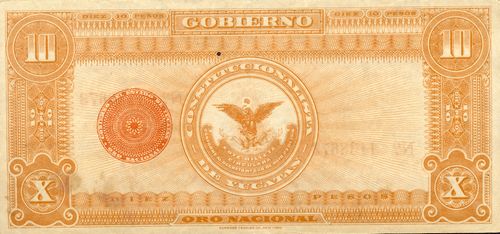 M4136a $10 Tesorería General
M4136a $10 Tesorería General
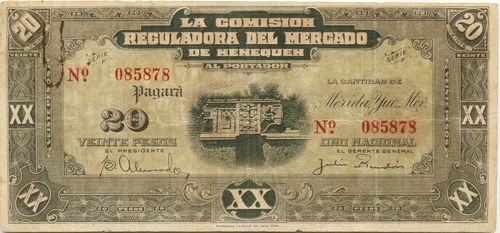
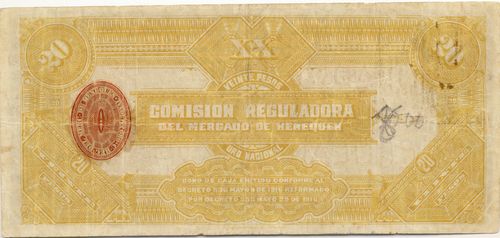 M4165a $20 Comision Reguladora
M4165a $20 Comision Reguladora
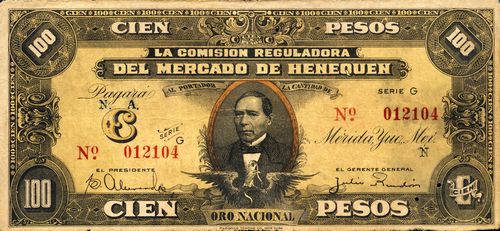
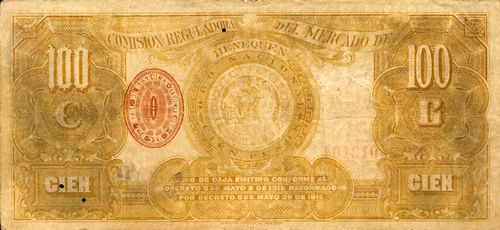 M4166a $100 Comision Reguladora
M4166a $100 Comision Reguladora
On 19 August H. F. Payne wrote to the ABNC about a “second order executed by the American Lithograph Company, for 750,000 sheets of notes, 48 notes to a sheet (i.e. 36,000,000), printed in four colours on the face and one colour on the back. There are five denominations and each note is numbered in duplicate. The steel plates from which the transfers are to be made are being prepared by the Steel Engraved Securities Corporation (an offshoot of R. E. Noble & Co.) in New York. On the previous order the Lithograph Company got a bonus of five thousand dollars for making delivery ahead of schedule, and the matter of time on this lot is equally important.”ABNC, folder 210, Republic of Mexico (1916 (July) – 1935 letter H. F. Payne, Boston, Mass. 10 August 1916.
The Parsons Trading Company undertook to complete delivery of the notes by 31 October, and we know that 720,000 $1 notes were dispatched on the steamer “Esperanza” on 21 September, but other consignments dragged on into December.
The notes were sent still in sheets (so that they could be charged as paper rather than banknotes) and had to be cut and stamped once they reached Mérida. The Secretaría de Hacienda in Mexico City sent a team of six peopleGerardo Chávez, Fernando Torres, Juan Montes de Oca, Miguel Portilla, Jesús Herrerías and José L. Guerrero and on 8 September the person in charge of issuing notes and cartones, Nicolás Ferraez, arranged for them to be paid five pesos a day for their laboursAY, Fondo Poder Ejecutivo Salvador Alvarado 1915-1917, Sección Tesorería General del Estado de Yucatán, Serie Hacienda Pública, vol. 199, exp. 27, letter Tesorero General to governor, Mérida, 12 September 1916.
On 29 October 1918 the new inspector, F. Irabién Rusat the start of the revolution Irabién Rus had joined the Oficina Impresora of the Secretaría de Hacienda, and had headed the Oficina de Resello in Veracruz, Mérida and Tabasco, reported to the governor on the overstamping of the Comisión Reguladora notes. Machines had deteriorated and materials were poor or lacking, so he suggested a visit to Mexico City to purchase new materialsAY, Fondo Poder Ejecutivo 1918, Sección Secretaría General de Gobierno, Serie Gobernación, vol. 410, exp. 28, letter F. Irabién Rus to governor Carlos Castro Morales, 29 October 1918. He added a list of the things that he needed:
| 50 stamps (dados de resello) for the ‘Gobierno del Estado de Yucatán’ | $ 150.00 |
| 50 stamps (dados de resello) for the ‘Comisión Reguladora del Mercado de Henequén’ | 150.00 |
| 50 kilos of red die (polvo rojo carmín obscuro francés) | 300.00 |
| 50 gallons of Marniz Dmar Número 2 claro | 900.00 |
Not all of these notes were put into circulation, or even stamped once they had reached Mérida. In fact less than half in value (and just over half in number) were issued. All the $1 and $10 notes were put into circulation but only 72,000 (29%) of the $2, 432,000 (14%) of the $5, 100,400 (20%) of the $20 and 15,000 (15%) of the $100 values. The rest were incinerated in May and June 1919.
| Series | from | to | total number |
total value |
code | ||
| $1 | A | 000001 | 5000000 | 5,000,000 | $ 5,000,000 | includes numbers 2889062CNBanxico #6509 to 4988529CNBanxico #6510 | |
| $2 | B | 000001 | 715000 | 715,000 | 1,430,000 | includes numbers 220562CNBanxico #6511 to 419488CNBanxico #6512 | |
| 715001 | 2500000 | 1,785,000 | 3,570,000 | without seals or contraseñas, incinerated on 7 June 1919Diario Oficial, Yucatán, Año XXII, Núm. 6629, 10 June 1919 | |||
| $5 | C | 000001 | 432,000 | 2,160,000 | O.E.1 | includes number 0046007 | |
| M.P.3 | includes number 0135110 | ||||||
| S.O.U | includes number 0181468 | ||||||
| A.T.U. | includes number 0196009 | ||||||
| O.N.A | includes number 0300260CNBanxico #6513 | ||||||
| O.D.8 | includes number 0331317 | ||||||
| 0432000 | |||||||
| 0432001 | 3000000 | 2,568,000 | 12,840,000 | without seals or contraseñas, later destroyedDiario Oficial, Yucatán, Año XXII, Núm. 6609, 17 May 1919. 2,568,000 notes were not stamped: I have assumed that they were dealt with sequentially. 1,002,000 of these notes were incinerated on 10 May 1919 and a further 1,578,510 incinerated on 24 May 1919 | |||
| $10 | D | 000001 | 1500000 | 1,500,000 | 15,000,000 | includes numbers 1138673 to 1472095CNBanxico #6514 | |
| $20 | F | 000001 | 100400 | 2,008,000 | includes number 085878 | ||
| 100401 | 250400 | 3,000,000 | with seals or contraseñas but not issued and incinerated on 24 May 1919Diario Oficial, Yucatán, Año XXII, Núm. 6621, 31 May 1919. I have assumed that the notes were dealt with sequentially | ||||
| 250401 | 500000 | 249,600 | 4,992,000 | without seals or contraseñas, incinerated on 10 May 1919Diario Oficial, Yucatán, Año XXII, Núm. 6609, 1919. $4,992.000 in notes were not stamped: I have assumed that they were dealt with sequentially | |||
| $100 | G | 000001 | 15,000 | 1,500,000 | L.E. | includes number 000127CNBanxico #12405 | |
| T.O. | includes number 003800 | ||||||
| L.D.1 | includes number 007791 | ||||||
| S. 1 | includes number 007989 | ||||||
| R.L.1 | includes number 008204CNBanxico #6553 | ||||||
| N.A.N | includes number 012104 | ||||||
| 015000 | |||||||
| 015001 | 100000 | 85,000 | 8,500,000 | never issued. $6,500,000 in notes incinerated on 7 June 1919Diario Oficial, Yucatán, Año XXII, Núm. 6629, 10 June 1919 | |||
| 12,600,000 | $60,000,000 |
Incinerations
We have details of the following incinerations of used notes
| Acta | 50c | $1 | $2 | $5 | $10 | $20 | $100 | total number |
total value |
|
| 25 January 1919witnessed by Carlos Castro Morales, governor and so president of the Comisión Reguladora; Alfonso M. Alonso, Secretario General del Gobierno; Armando G. Cantón, gerente of the Comisión Reguladora; Pedro Palma Puerto, Rafael Peón Arana, Joaquín Suárez Villámil, Alvaro Medina Ayora, vocales; Diodoro Domingo, book-keeper; Julio Sierra Ugarte, Inspector Oficial Federal of the Comisión Reguladora; Héctor Moreno Irabién, Eduardo Castillo C., Francisco M. Torres S., Jafet Osorio Gutiérrez, José Carpizo H., Rafael Aguiar Rosas, Delio S. León, Pablo Torres C., Federico Bolio and Nicanor Elizalde, employees (Diario Oficial, Año XXII, Núm. 6609, 17 May 1919) | 3 | 30,000 | 30,000 | $30,000 | ||||||
| 8 February 1919witnessed by Carlos Castro Morales, governor and so president of the Comisión Reguladora; Alfonso M. Alonso, Secretario General del Gobierno; Armando G. Cantón, gerente of the Comisión Reguladora; Rafael Peón Arana, Joaquín Suárez Villámil, Gustavo Arce, Pedro Solis Cámara, vocales; Diodoro Domingo, book-keeper; Julio Sierra Ugarte, Inspector Oficial Federal of the Comisión Reguladora; Héctor Moreno Irabién, Eduardo Castillo C., Francisco M. Torres S., Pablo Torres C., Jafet Osorio Gutiérrez, M. Arceo A., José Carpizo H., Rafael Aguiar Rosas, Manuel Rubio, Fernando Casares V., Federico A. Bolio and Nicanor Elizalde, employees (Diario Oficial, Año XXII, Núm. 6609, 17 May 1919) | 5 | 30,000 | 30,000 | 30,000 | ||||||
| 8 March 1919witnessed by Carlos Castro Morales, governor and so president of the Comisión Reguladora; Alfonso M. Alonso, Secretario General del Gobierno; Armando G. Cantón, gerente of the Comisión Reguladora; Antonio Ancona Pérez, Gustavo Arce, vocales; Diodoro Domingo, book-keeper; Julio Sierra Ugarte, Inspector Oficial Federal of the Comisión Reguladora; Héctor Moreno Irabién, Pablo Torres C., M. Arceo A., Manuel Rubio, Federico A. Bolio and Nicanor Elizalde, employees. (Diario Oficial, Año XXII, Núm. 6609, 17 May 1919) | 14 | 40,000 | 40,000 | 40,000 | ||||||
| 29 March 1919witnessed by Carlos Castro Morales, governor and so president of the Comisión Reguladora; Alfonso M. Alonso, Secretario General del Gobierno; Armando G. Cantón, gerente of the Comisión Reguladora; Antonio Ancona Pérez, R. A. Peón, vocales; Diodoro Domingo, book-keeper; Julio Sierra Ugarte, Inspector Oficial Federal of the Comisión Reguladora; J. Escalante, E. Castillo, José Carpizo H., Fernando Cásares V., Héctor Moreno Irabién, Pablo Torres C., R. Aguiar R., M. Arceo A., Manuel Rubio, J. Otero G. and Nicanor Elizalde, employees. (Diario Oficial, Año XXII, No. 6621, 31 May 1919) | 17 | 50,000 | 50,000 | 50,000 | ||||||
| 12 April 1919witnessed by Carlos Castro Morales, governor and so president of the Comisión Reguladora; Alfonso M. Alonso, Secretario General del Gobierno; Armando G. Cantón, gerente of the Comisión Reguladora; Pedro Palma P., A. Medina Ayora, R. A. Peón, vocales; Diodoro Domingo, book-keeper; Julio Sierra Ugarte, Inspector Oficial Federal of the Comisión Reguladora; J. Escalante E., José Carpizo H., Fernando Cásares V., Héctor Moreno Irabién, Pablo Torres C., R. Aguiar R., M. Arceo A., Manuel Rubio, J. Otero G., J. Osorio Gutiérrez, Francisco M. Torres S. and Nicanor Elizalde, employees. (Diario Oficial, Año XXII, No. 6621, 31 May 1919) | 21 | 40,000 | 40,000 | 40,000 |
Further incinerations were made in November and DecemberDiario Oficial, Año XXIII, No. 6835, 10 February 1920.
The Comisión also incinerated sheets of notes that had not been put into circulation.
| Acta | 50c | $1 | $2 | $5 | $10 | $20 | $100 | total number |
total value |
|
| 10 May 1919 | 1,002,000 | 249,600 | 1,251,600 | $10,002,000 | ||||||
| 24 May 1919Diario Oficial, Año XXII, No. 6621, 31 May 1919 | 1,578,510 | 150,000 | 1,728,510 | 10,829,550 | ||||||
| 7 June 1919Diario Oficial, Año XXII, No. 6629, 10 June 1919 | 1,785,000 | 65,000 | 1,850,000 | 10,070,000 |

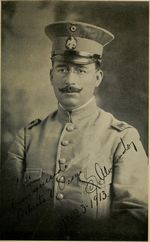 Salvador Alvarado was born on 16 September 1880, in Culiacán, Sinaloa. As a young man, he moved to the port of Guaymas, Sonora, and then to Cananea, Sonora, where he opened his own pharmacy and worked for several years as a pharmacist and merchant. In 1906, he joined the Partido Liberal Mexicano (Mexican Liberal Party) of the Flores Magón and in 1910 joined the Anti-Reelectionist Party in Sonora. In the same year, he and other young idealists attacked a military barracks in Hermosillo. After its failure Alvarado escaped into Arizona.
Salvador Alvarado was born on 16 September 1880, in Culiacán, Sinaloa. As a young man, he moved to the port of Guaymas, Sonora, and then to Cananea, Sonora, where he opened his own pharmacy and worked for several years as a pharmacist and merchant. In 1906, he joined the Partido Liberal Mexicano (Mexican Liberal Party) of the Flores Magón and in 1910 joined the Anti-Reelectionist Party in Sonora. In the same year, he and other young idealists attacked a military barracks in Hermosillo. After its failure Alvarado escaped into Arizona.

